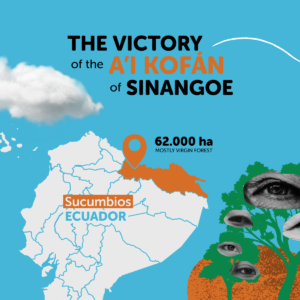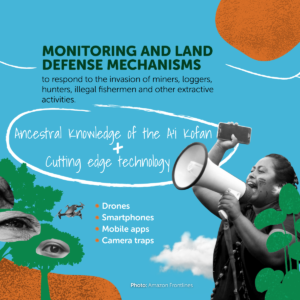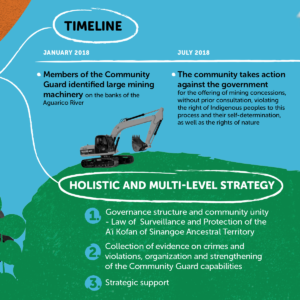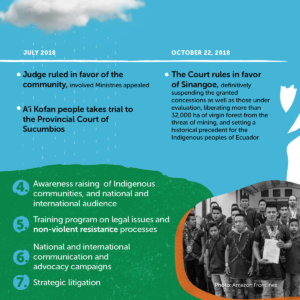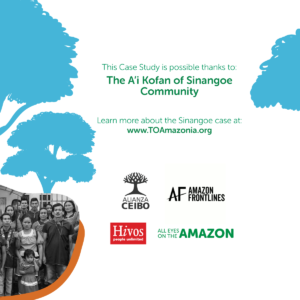Paths of Resistence – Case Studies Series
This case study shows how the Sinangoe community, located in the Sucumbíos province in Ecuador, developed and implemented, in collaboration with key partners, a combination of strategies (community land surveillance and monitoring with the use of technology, collection of evidence, strategic litigation, internal and external communications and advocacy) that successfully resulted in a positive legal decision for the protection of the A’i Cofán Indigenous people’s self-determination and land rights.
1. Case Study Video
2. The Case Study in a Nutshell
3. Read the full case
Show moreBasic information
Indigenous people: A’i Cofán
Locality: Sinangoe Community, Province of Sucumbíos, Ecuador. Located on the banks of Aguarico River, at the limits of Cayambe Coca National Park
Area: 55,000 hectares, mostly of virgin forest
Population: 38 families
Activities: fishing, hunting, craftwork
Governance: decisions taken collectively at community meetings
Website
Facebook
AEA partner involved: Sinangoe is an ally of Alianza Ceibo.
3.1. Context and Challenges
- The A’i Cofán of Sinangoe Indigenous land has been invaded for many years by illegal miners, loggers, hunters and fishermen. The community requested government action several times, but no solution was provided.
- In January 2018, the Ecuadorian government granted dozens of concessions within the A’i Cofán ancestral land, without prior consent or communication with the community. At the time, Sinangoe filed a complaint with the provincial and national authorities, but received no reply.
- In July 2018, the community filed a lawsuit against the Ministry of Environment, the Ministry of Energy and Non-Renewable Natural Resources, the Mining Regulation and Control Agency (ARCOM) and the Water Agency (SENAGUA) for violations of the right of Indigenous peoples to prior consent; the right to a healthy environment; the right to water, food, health and life; and the rights of nature. The judge ruled in favor of the community; however, the Ministries immediately appealed the ruling. So, the trial was taken to the Provincial Tribunal Court of Sucumbíos in September 2018.
- During this period (July to September), the community undertook a set of actions and, on September 6, 2018, the Court finally ruled in favor of Sinangoe, permanently suspending both the concessions granted and those under evaluation, thus freeing more than 32,000 hectares of native forest from the threat of mining and setting a historic precedent for the Indigenous peoples of Ecuador.
Credit: MapBiomas Amazonia
3.2. Strategies: key-factors to overcome the challenges
The following is a list of key factors for Sinangoe’s legal victory against the Ecuadorian government. Some were already in place prior to the identification of the challenge, and formed an important basis for the case (such as the decision-making process through community meetings), while others were developed as part of the ad-hoc strategy.
Credit: Amazon Frontlines
- Partnerships and Alliances: The strategic support gained from several organizations was a key success factor. Alianza Ceibo (an Ecuadorian non-profit organization comprising four Indigenous nationalities: A’i Kofan, Siekopai, Siona and Waorani) and Amazon Frontlines provided institutional and technical/legal support throughout the case process, including the formalization and training of the Community Guard, the revitalization of the community’s traditions and ancestral knowledge, capacity building on human and Indigenous rights issues, and legal and communication advice, among others. Digital Democracy supported Sinangoe by providing land mapping technical consultancy and technologic equipment. Lastly, the political will of the Ecuadorian Public Defenders’ Office (Defensoría del Pueblo) to collaborate with the Sinangoe case was also a relevant factor for the community’s victory.
- Community Governance: A key feature for the success of this case is the community organization, from which an organic structure and community unity is derived, in addition to the leadership of Sinangoe’s spokespeople within the scope of the legal battle. Sinangoe community members stress the importance of developing a shared vision of their values, the wealth of their land, their ancestral knowledge and ability to value everything they have. Thus, based on this commitment and community organization, a solid connection was also built with the spokespeople of the case as well as with partners of Alianza Ceibo and Amazon Frontlines, who had several days of conviviality in the community to learn more about the demands and to strengthen ties with its members. Moreover, the Sinangoe community works permanently through community meetings to address relevant events. Once the community monitors identified the mining activities in their land, they presented that evidence to the community, who decided at a meeting to proceed with the strategic litigation. This collective participation is the reason why the leaders did not have to mobilize the community to carry out actions, but rather everything they implemented was based on the initiative of the community members themselves. This strategy was especially important, enabling them to garner the support and commitment of all members of the community to Sinangoe’s legal case.
- Establishment of their Own Law and Regulations: Within the framework of the Constitution of Ecuador (Article 57, number 10), which establishes that Indigenous peoples can create, develop, apply and practice their own or customary law, in 2017, the A’i Kofan community developed, with the support of Alianza Ceibo, their own Law of Control and Protection of the A’I Kofan Ancestral Land of Sinangoe – a need identified and part of the initial steps to provide a strategic response to the challenge they face in their territory. The Law regulates what outsiders are and are not allowed to do in Sinangoe territory and, as it is applied only to outsiders, it avoids the need to discuss each case individually and also ensures clear communication from communal spokespeople about the rules applied to people outside the community. The written record of their Law (an unusual practice for them) is also intended to ensure government recognition of their own rules. Lastly, the Law also made official the creation of the Community Guard, although Sinangoe was already promoting the monitoring of its land as a common practice prior to the creation of its Law.
- Land Monitoring and Mapping with the Use of Technology: The Community Guard has played a key role in obtaining evidence of land destruction including deforestation, the entry of heavy machinery, the creation of ponds for ore washing, and chemical pollution in the river, among other impacts. They were the ones who identified and produced the evidence of the damage caused by the mining concessions to the community, which then collectively decided on how to respond. The creation of surveillance and monitoring protocols allows the Community Guard to carry out its work in a more secure manner. They also received training from Digital Democracy on how to combine their ancestral knowledge with technological tools and systems during their patrolling activities.
- Collection of Evidence: During their patrols, evidence collection promoted by the Community Guard is carried out through: installation and monitoring of camera traps; recording on maps the GPS coordinates of what they find; drone operation; video recording; monitoring and digital mapping through Mapeo app, among other activities. During these patrols, the Guard documents evidence of land invasions and damage caused to their forests and rivers. For example, they have mapped who and how many people entered their territory illegally, with the help of camera traps. They also mapped how a mining concession destroyed fifteen hectares of native forest and polluted the Aguarico River.
- Capacity Building in Human Rights, Self-Determination and Legal Rights: Alianza Ceibo, with technical support from Amazon Frontlines, promoted an intensive training program for community members, which covered legal issues as well as non-violent resistance processes. The goal was to empower the people of the indigenous communities, so that the proposed initiatives would come from those who know their problems best. As a result, Alianza Ceibo began submitting proposals to Amazon Frontlines to file lawsuits that could be as simple as requesting information from the government or as complex as the Sinangoe case. In this process, the importance of identifying the most suitable training format stands out; for example, at the beginning, before creating this intensive training program, one- to three-day workshops were promoted, which turned out to be insufficient.
Credit: Alianza Ceibo
- Internal Awareness: Alianza Ceibo implemented a general strategy to enhance awareness among the indigenous communities it works with about the damages and risks related to extractive activities, and helped involve the other nationalities (Siekopai, Siona and Waorani) in supporting the A’i Cofán cause. Overall, the governance structure and community engagement were key to ensuring better coordinated measures, increasing social pressure on the authorities and gaining national and international support, leading to greater political impact at the national level.
- Advocacy and Campaigns: Every week, the legal and communications team of Alianza Ceibo and Amazon Frontlines met with community members who, as part of the integral strategy, went on radio shows, press conferences and protests to talk about their own experiences and appeal to people’s emotions about the challenges faced: a personal narrative has a stronger appeal than a legal discourse that may be unappealing to most people. At the national level, Sinangoe’s communication strategy did not focus on dialogue or negotiation with government entities, although they had not ruled out the possibility of exhausting all existing channels. However, the team identified state entities, such as the Public Defenders’ Office, with the political will to fight for the defense of the Amazon and the institutional capacity to pressure the Executive Branch. To raise national and international awareness of Sinangoe’s cultural and environmental wealth, the community, Alianza Ceibo and Amazon Frontlines had social networks and web pages dedicated to building awareness and sensitizing people about the case.
- Mobilization of Indigenous Peoples: During the litigation process, the Sinangoe community engaged in several mobilizations denouncing to Ecuador and the world the violation of their rights resulting from the promotion of mining activities in their territory. The organization of these mobilizations linked to communication, advocacy and campaign actions is a strategy usually applied by Alianza Ceibo and Amazon Frontlines, which generates a greater impact on awareness and sensitization. From these mobilizations, the A’i Cofán of Sinangoe received the support of several national and international organizations, which gave them the strength to continue their struggle.
- Strategic Litigation: Although lawsuits are unique to each community’s case, strategic litigation should always be the goal, as it seeks to resolve a particular, personal problem while providing a solution for all similar problems. Hence, the Sinangoe legal case was developed to also serve the causes of other indigenous peoples facing similar threats. The A’i Cofán people based their strategy on the assumption that legal action is simply one more tool that must be supplemented by other strategies. In addition, the whole lawsuit was based on a grassroots movement and was conducted by people of the A’i Cofán nationality – who received specific technical advice to perform this role. Amazon Frontlines provided legal advice: it was not an outside attorney who proposed the case or filed the actions. In fact, the legal case was pursued by the community representatives themselves, who also actively took part in lobbying the authorities Finally, Sinangoe’s strategy also included making judges, authorities and journalists aware of the damage caused by mining in situ, which allowed the judge to observe first-hand (as well as with the help of drones) the impacts made by the backhoes in a short operation period. The combination of all these strategies was essential to Sinangoe’s victory in a relatively short period of time (approximately three months after the lawsuit was filed).
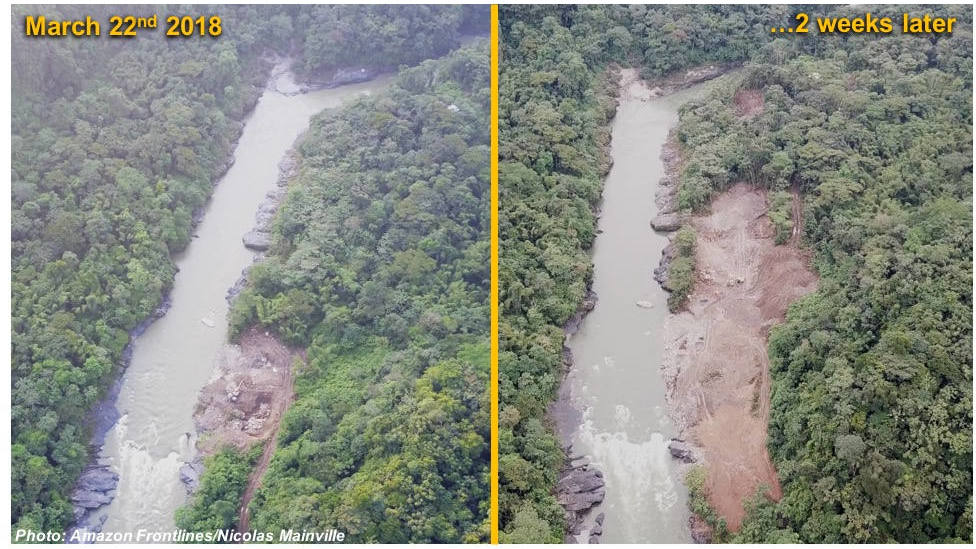
Credit: Amazon Frontlines / Nicolas Mainville
3.3. Benefits: added value and case impacts
- Strengthening of Territorial Monitoring and Mapping with the Use of Technology: By combining ancestral knowledge and state-of-the-art technology, the Community Guard has a great system for monitoring and mapping their territory. From the monitoring activities, evidence gathering was essential to the community’s victory over the government. That experience has prompted the Community Guard to record on maps (both physical and digital, using the Mapeo app) important wildlife sites, medicinal plants, the paths used by their grandparents, etc. This registration will help Sinangoe’s A’i Cofán people in the process of titling their territory, as well as to understand and value their memory and cultural heritage, of great importance for the youth.
- Women’s Participation in Territorial Monitoring and Mapping: To date, one woman has been trained and is a member of the A`i Cofán Community Guard, opening up opportunities for other women and for the Guard system itself. The community agrees that women’s participation is fundamental because of their ability to speak more calmly and accurately with the invaders, and due to their organizational skills. On the other hand, to participate, women must overcome the challenges of balancing this role with other typical roles such as mother and wife. Alexandra Narváez, the first woman to join the Community Guard, considers that: “If there is a woman who feels stronger [to be part of the Community Guard], then I think, ‘Yes, I can do it too. I want to speak for my territory like my fellow women speak’ – and that gives one more strength in wanting to be a guard.”
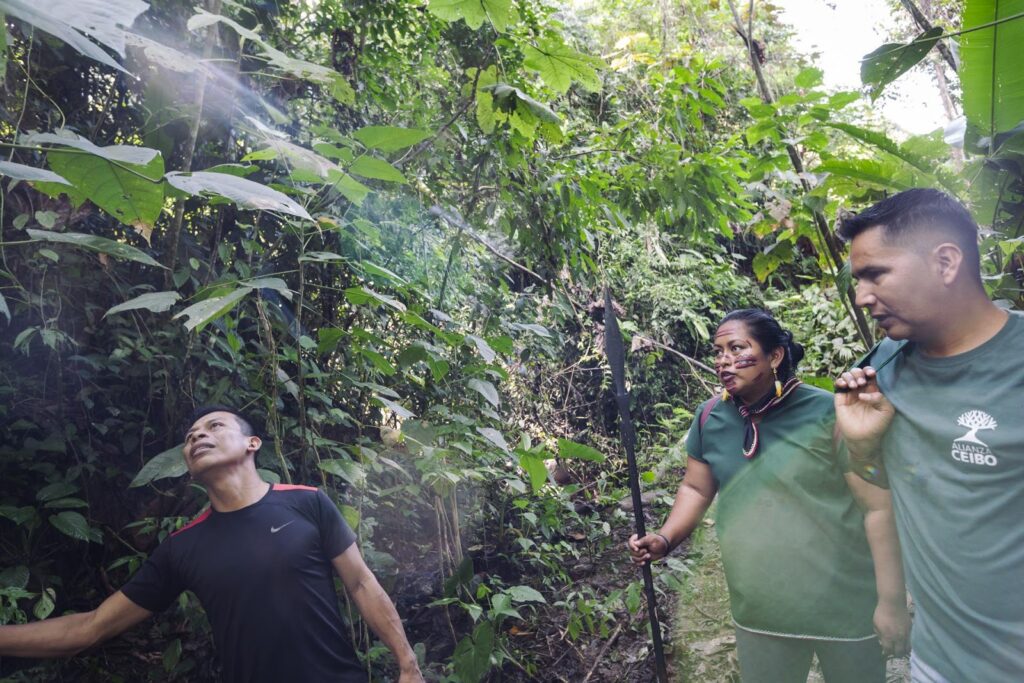
Credit: Hivos
- Community Unity and Synergies: As mentioned previously, the governance of the Sinangoe community has long been collaborative, with decisions made jointly at community meetings. However, the process of this case and the final victory have bolstered community empowerment. – The increased solidarity between Sinangoe’s A’i Cofán people and other nationalities was also observed: Through Alianza Ceibo and other partners, the A’i Cofán people are in constant coordination to promote mobilization, advocacy actions and exchanges with other nationalities to share experiences on territorial defense strategies, ultimately supporting the protection of their territorial rights and those of other peoples.
- Protection of Defenders: The role of the Guard and indigenous spokespersons was vital throughout the litigation process, from evidence gathering to mobilizations and campaign actions. The increased visibility of some of these community members also contributed to a reported increase in threats against them. This process highlights the relevance of their role and has provided further arguments for strengthening security measures for guards, as they face the greatest risks of violence, especially during patrolling. Alianza Ceibo has continued to work on the creation of networks for the protection of defenders that can respond to the growing threats on the ground.
- Legal Legacy: The ruling for the Sinangoe case set a precedent for future cases regarding violations of collective rights and environmental damage caused by mining and river pollution, and for everything related to advance consultation, self-determination and self-government of indigenous communities in Ecuador. It was chosen by the Ecuadorian Constitutional Court to develop national case law on the systematic violation of the right to self-determination. The Sinangoe community, in cooperation with Alianza Ceibo and other partners, is in continuous coordination to ensure government compliance with the legal decision in practice.
4. Chronology
See more information about:
- Alianza Ceibo: The Sinangoe Struggle
- Amazon Frontlines: Stand with Sinangoe
- All Eyes on the Amazon: Learning Trip of Sinangoe’s A’i Cofán de Community

